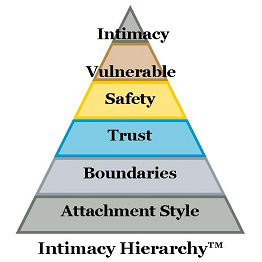Estimated reading time: 3 minutes
 It is true that each person & each couple has individualised ideas about what makes up intimacy. Nevertheless there are some common elements of intimacy that recur in modern cultures. What are these common elements? To begin with, here are five components which create intimacy, although there are more. These can be featured when you’re just beginning a relationship or when wanting to renew the intimacy in a long-term relationship.
It is true that each person & each couple has individualised ideas about what makes up intimacy. Nevertheless there are some common elements of intimacy that recur in modern cultures. What are these common elements? To begin with, here are five components which create intimacy, although there are more. These can be featured when you’re just beginning a relationship or when wanting to renew the intimacy in a long-term relationship.
Spend time together
First, people who are intimate spend time together. Spending time together allows you to find out about the other person, to get to know them on deeper levels, to start sharing personal details, all of which helps us to get close to someone. Getting close can predispose us to want to collaborate and find points of agreement on topics of discussion or activities we wish to pursue. This creates the impetus to be more collaborative than competitive. In fact this is how affairs get started at workplaces, conferences or when attending classes/courses in which we’re interested.
Talk about sensitive topics
Second, people who are intimate talk about particular topics – their past, sensitive subjects, vulnerabilities, personal hopes, longings and aspirations. It has been observed that men (in general, and not all men) don’t share vulnerable feelings like embarrassment, fear or hurt, and instead display only one emotion – anger. If people, especially men, are stirred to talk about what hurts or scares them, couples more generally become more intimate. In particular, discussing past or future hopes and dreams opens up the way for deeper, more vulnerable conversations. When this is done in an intimate relationship, there is often the unspoken assumption that these dreams will be respected and not made fun of.
Affectionate touching
Third, there is quite a lot of affectionate touching in intimate relationships. When people feel attracted or close, they generally touch each other a lot. We do things like “accidentally” brush up against each other, make eye contact, sit close, hold hands, hug and kiss. If it is a sexual relationship, there’s sexual touching as well. Two things are occurring at this time. There’s a discarding of blame, put-downs and criticisms – all of which create barriers to intimacy – and there are clear behaviours which enhance intimacy, like acceptance, encouragement and compliments.
Enough compatibilities
Fourth, there’s a belief, either real or imagined, that there are many similarities and compatibilities. This can seem to happen automatically when we meet a new person to whom we’re attracted. But it can also be reawakened in an existing, long-term relationship. We can spend time doing things that both enjoyed in the past or we can seek out new and novel ways of spending time together. Novelty creates closeness, especially when we’re doing something new, challenging and exciting. The thrill of excitement creates bonds of intimacy.
Feelings matter
Fifth, intimacy is created when both people know that their feelings matter. When both people know that feelings matter, there’s a priority placed on being connected rather than being right. Being right destroys intimacy. Being connected restores intimacy. Connection is the magic ingredient for true intimacy.
To book your appointment call me on (0421) 961 687 or contact me. You can book a Skype session with me if you cannot personally come to either of my practice locations. If you’re not ready to book an appointment, call me on (0421) 961 687 to book a FREE 15 minute phone consultation to discuss how I may be able to assist you.

Are you able to explain your Intimacy Hierarch and what you mean by vulnerability before the top level? Is there an explanation of each step?
Hello Ruth, thanks for your question. Each step is explained in more detail on this page. The vulnerabilities are different for each person. Generally it means that once a secure enough bond has occurred, that partners share things with each other that reveal deeper & more sensitive parts of themselves. This blog may also help. All the best, Vivian.